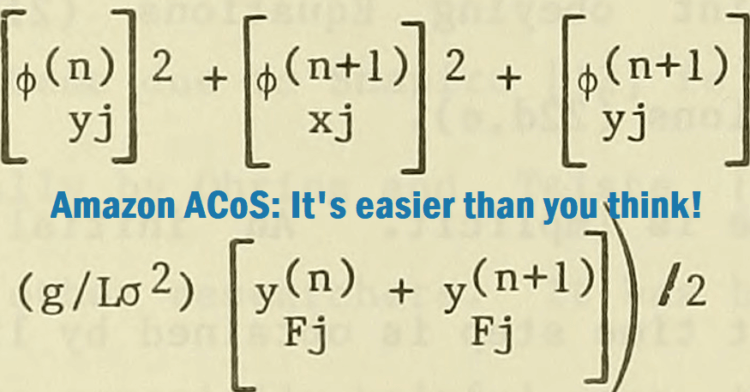When you’re measuring your performance on Amazon, advertising cost of sale (ACoS) is one of the most important metrics to keep track of. It can determine the effectiveness (or ineffectiveness) of your advertising campaigns, and impact how well you’re scaling towards your business goals.
Here’s a quick look at how you should interpret ACoS on Amazon, how to calculate it, and the steps you can take to lower your ACoS and make your advertising campaigns more efficient.
- What is Amazon ACoS?
- How to calculate ACoS on Amazon
- What is considered a good ACoS?
- How to lower ACoS
What is Amazon ACoS?
ACoS stands for advertising cost of sales and is a key metric used to measure the profitability of Amazon Advertising campaigns. It is calculated by dividing the total amount spent on advertising by the total amount of sales generated from those ads.
For example, if you spend $100 on advertising and generate $200 in sales, your ACoS would be 50%.
A lower ACoS is generally considered to be better, as it indicates that you are spending less money on advertising to generate the same amount of sales. However, the ideal ACoS will vary depending on your product costs, advertising goals, and budget.
There are a number of factors that can affect your ACoS, including:
- The competitiveness of your product category
- The quality of your product listings (which affects your conversion rate)
- The relevance of the keywords being targeted in your ad campaign
You can improve your ACoS by optimizing your product listings, targeting relevant keywords, and paying attention to your competition. You can also experiment with different bidding strategies to find what works best for your products.
To find relevant, high-search volume keywords for your listings and ad campaigns, check out Keyword Scout.
ACoS is an important metric to track, as it can help you to make informed decisions about your Amazon advertising campaigns. By understanding your ACoS, you can identify areas to improve your profitability and maximize your advertising budget.
How to calculate ACoS on Amazon
Simply put, ACoS is calculated using the following formula:
ACoS = 100 x ( [total ad spend] ÷ [total sales] )
In other words, if you spend $50 on advertising and it results in a single sale of $100, your ACoS would be 50%:
100 x ([50] ÷ [100]) = 100 x 0.5 = 50%
Using Jungle Scout’s Advertising Analytics tool, you can track and monitor key metrics like total sales, ACoS, and TACoS (Total Advertising Cost of Sale) to see the effect your advertising has on your organic sales.
TACoS (total advertising cost of sales ) is a metric that accounts for all of your Amazon sales revenue, ad sales and organic sales, while advertising cost of sales (ACoS) only accounts for the sales that are attributable to your ads.
This means your ACoS will always be higher than your TACoS because it only accounts for a portion of your total sales.
READ MORE | What Is Amazon TACoS (Total Advertising Cost of Sale)?
What is considered a good ACoS?
Generally speaking, a low ACoS is a good ACoS. However, what you determine as “low” may vary by product and your goals.
The lower your ACoS, the less you’re spending on advertising for that sale. That means your campaigns and keyword targeting are efficient. A higher ACoS, on the other hand, can mean your advertising campaigns are inefficient, possibly due to irrelevant keywords or campaign structure.
With that said, here are some general ACoS benchmarks:
-
- A low ACoS is under 25%. If you’re under 25% for ACoS, then conversions are high for that keyword or product. You may want to consider raising your bid to increase clicks and overall traffic for that term/product.
- An average ACoS is between 25% to 40%.
- A high ACoS is above 40%. This might happen when a specific keyword is gaining a lot of traffic, but has a low conversion rate. This represents a good opportunity to rethink the keywords you’re currently bidding on.
Now keep in mind that if your ACoS is high, it does not necessarily mean your product or business is unprofitable. Sellers must also be aware of their TACoS (total advertising cost of sale) to measure the effectiveness of their ad campaigns and organic sales.
How to lower ACoS
One thing we commonly hear from sellers is, “I want to achieve improvements in both volume (increasing orders/revenue) and [Return on Investment] (decrease ACoS) – and I want to accomplish this quickly!”
However, volume and efficiency can be competing goals. Working towards one can undermine the success of the other.
For that reason, you need to ask yourself: Are my goals growth-based (volume) or ROI-based (efficiency)?
For example, if you’re launching a new product, you might sacrifice profitability for volume and speed. The goal during launch is usually to get as many eyes as possible on your product. You’re trying to build awareness quickly, contributing to a higher ACoS.
Conversely, if you are on a tight budget and need to hit revenue targets, you want to get your ACoS as low as possible. You want to make the most efficient use of your marketing dollars on Amazon.
More ways to lower your ACoS on Amazon:
- Adjust your keyword bids to ensure you aren’t paying too much per click.
- Adjust your product or keyword targeting to ensure you’re reaching a relevant audience.
- Remove poor-performing keywords and add them as negative keywords so your product doesn’t appear in search for that keyword.
- Optimize your product listing copy and images to improve conversions.
To learn more about optimizing your Amazon PPC campaigns, check out this YouTube video:
What is your ACoS on Amazon?
ACoS is an important metric for evaluating the success of your advertising campaigns on Amazon. But it’s equally important to view your ACoS in the context of your overall goals.
For sellers who want to grow quickly, or build awareness for a product listing by driving traffic to it, a higher ACoS is inevitable.
However, if your goal is to minimize wasted ad spend and hit ROI targets, then lowering your ACoS is possible. By adjusting bids for keywords or product targeting that aren’t converting efficiently, you can lower your costs.
To sum it all up:
- A good ACoS is relative to your marketing and business goals.
- A high ACoS is acceptable if your goals are volume and speed for faster growth.
- If you want to lower your ACoS for efficiency goals, you need to adjust bids for low converting keywords.
- Total profitability > Lower ACoS.
If you’ve had success lowering your ACoS on Amazon using alternate methods, please share them in the comment section below. We’d love to hear from you!

 No Comments
No Comments